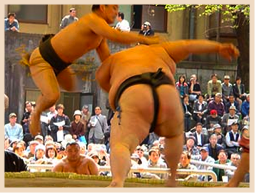
Todd Jay Leonard, Blog


My last column dealt with sumo wrestling and the history of it, as well as the severe lifestyle and dedication needed to be a top-ranked sumo wrestler in Japan. A reader wrote to ask about the "topknot" of sumo wrestlers and the significance of having the hair so manicured.
That is a good question. The hairstyle actually serves two purposes:
1. It is to help protect the wrestler's head from injury.
2. It symbolizes the sanctity of the sport and his position within the world of sumo.
In fact, the people in charge of coifing the hair of a sumo wrestler have to train for 10 years before being allowed to touch the hair of a top-ranked wrestler. Apprenticeship of the traditional arts of Japan, including sumo, is a time-honored tradition with generations of family members often performing the same function as their ancestors.
The unique style of a sumo wrestler's topknot is significant because the hairdresser must mold and shape the hair, applying copious amounts of oil, into the shape of a ginkgo leaf. This style is reserved for only the top-ranked wrestlers to don before matches.
If a lower-ranked wrestler goes out of his stable building into the public, he is always expected to wear a kimono with geta (wooden clogs) and have his hair tied in a topknot called "chommage" (if it is long enough) which was typical of men in the Edo Period.
As mentioned before, only the top-ranked wrestlers are allowed to have their hair oiled and combed in the "oichomage" (gingko leaf) style during tournaments. Once a top-ranked wrestler retires, there is a special "haircutting" ceremony that takes place in the ring.
The wrestler, dressed in formal kimono, sits in the center of the ring as family, friends, fellow wrestlers and celebrities who are fans take turns in snipping bits of his hair. This is a very emotional ceremony, and often the wrestlers aren't able to hold back the wave of emotion that engulfs them at having such a visible part of their sumo identity taken away from them.
Before every Grand Sumo Tournament, a new dohyo (ring) is made by hand by a legion of 40 specialists for four days. The dohyo is considered to be a sacred place - meeting ground for the gods - and only a select group of men are allowed to construct the ring before a tournament. It takes 10 years of training just to be able to choose the proper clay to use in the making of a sumo ring.
By hand, using only traditional tools - just as it was done 2,000 years ago - packed earth and the hard work of the 40 specialists combine to make a good dohyo.
These men are called "yobidashi," or beckoners/ushers, who, besides making the dohyo also beckon the wrestlers for their bouts and usher them into the stadium. They serve as referees, as well, for the bouts.
Yobidashi begin their training at the age of 15 and spend their whole lives honing their ability to create a perfect ring, and in becoming a "master yobidashi."
These men assist in all aspects of the sumo matches, from keeping the ring moist with water to prevent it from cracking to sweeping the loosened earth from the center to handing sweat towels to the wrestlers before and after their matches. They also are responsible for carrying the huge advertising banners of sponsors around the ring before the matches.
Sumo is rapidly becoming an international sport. Several times a year, exhibition matches are performed, and sometimes these are done overseas. Currently, the top-ranking wrestlers are largely foreigners who have come to dominate the sport. Two Mongolian wrestlers are now the top-ranked wrestlers, with a Bulgarian wrestler working his way up the sumo ladder.
The first foreigner to be promoted to the rank of "ozeki," a step down from the top-ranked "yokozuna," was a Hawaiian by the name of Konishiki. He dominated the sport in the 1990s. He was, and still is, huge in size and could thrust a smaller wrestler out of the ring with little to no effort. He was never promoted to the top rank because of a poor performance and that intangible "certain something" that is referred to as a "champion's dignity" that the Sumo Federation didn't feel he possessed.
Later, however, another Hawaiian by the name of Chad Rowen (known as Akebono in Japan) did attain the ultimate pinnacle of the sumo world by being promoted to "yokozuna."
Japan certainly wants sumo to be accepted internationally and is working hard to get it recognized as such, but it is causing a bit of a quandary, as it is becoming too dominated by foreign wrestlers. By pushing smaller, less powerful Japanese wrestlers to the sidelines, it is creating a sort of cultural conundrum amongst the purists who see sumo as a part of its indigenous heritage.
By TODD JAY LEONARD
Columnist
Topknot hairstyle in sumo wrestling signifies top-notch athlete in the ring
Monday, September 11 , 2006






